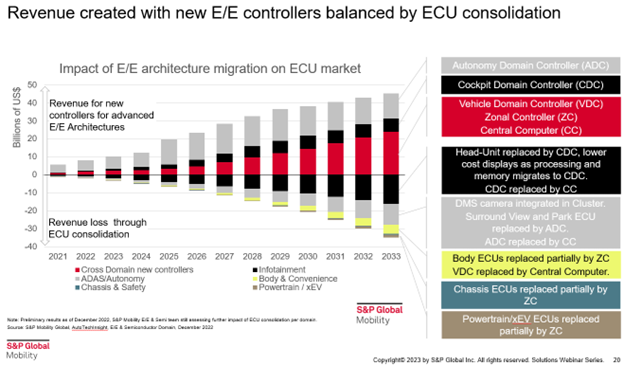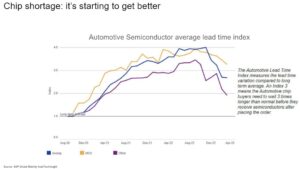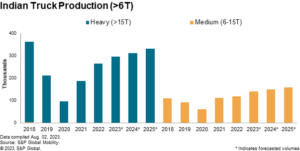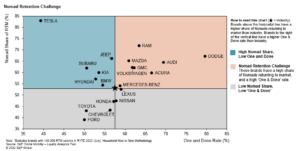AccessMobility News & Assets Community for
mobilitynews clippings, thought-leadership articles,
on-demand podcasts, webcasts and other assets of essential
intelligence- contributed by our team of experts and
partners.]
Evolving E/E architecture will drive the adoption of new
hardware based on domain and zone controllers, and eventually,
central computers. According to recent research by S&P Global,
addressable markets for control units will amount to an estimated
$40 billion of new ECU business in 2033 for Tier 1s—mostly for
autonomy-, cockpit-, and vehicle-domain controllers. Below the
line, the total market is offset by the consolidation of existing
ECUs as their functions are eventually absorbed into these more
powerful units. The result is still a net market plus, but the
replacement of existing ECUs will hit some suppliers harder than
others.

What’s at stake? S&P Global research shows that the
electronic ECUs in the various domains in the vehicles will start
to coagulate into fewer, larger hardware boxes with powerful
computers inside that address hardware in several or even all
domains. The cross-domain nature of these devices will challenge
suppliers—a zone controller integrates ECUs from various
domains based on location. Companies with narrow product offerings
such as cockpit or body ECUs that do not make ADAS ECUs will need
to partner with other tier 1s. This leads to revenue sharing and is
less attractive to OEMs seeking single solutions.
These “domain controllers” will thus cross domains in the
future, and the ability to serve several domains depends on the
knowledge base of the supplier. An example might be a powerful
Vehicle Domain Controller with a combined body, powertrain, and
chassis functions, or a central computer, e.g., with combined ADAS
and infotainment domains. These integration roadmaps will mean
specialized Tier 1s with single domain coverage must cooperate to
remain relevant—such as Magna (pure ADAS) and LG Electronics
(pure Infotainment) while others Bosch, Continental, Denso, or
Aptiv benefit from wider tool kits.
Find out more through the EE Architecture Revolution Webcast: https://lnkd.in/gfwE6cGu
This article was published by S&P Global Mobility and not by S&P Global Ratings, which is a separately managed division of S&P Global.
- SEO Powered Content & PR Distribution. Get Amplified Today.
- Platoblockchain. Web3 Metaverse Intelligence. Knowledge Amplified. Access Here.
- Source: http://www.spglobal.com/mobility/en/research-analysis/swings-and-roundabouts-who-benefits-from-new-ee-architecture.html
- :is
- ][p
- a
- ability
- According
- ADAs
- address
- Adoption
- All
- amount
- and
- aptiv
- architecture
- ARE
- article
- articles
- AS
- Assets
- At
- attractive
- base
- based
- BE
- below
- benefit
- benefits
- Billion
- body
- Bosch
- boxes
- business
- by
- central
- challenge
- chassis
- Cockpit
- combined
- community
- Companies
- computer
- computers
- consolidation
- continental
- contributed
- control
- controller
- COOPERATE
- coverage
- Cross
- data
- depends
- Devices
- Division
- domain
- domains
- drive
- e
- Electronic
- Electronics
- essential
- estimated
- Ether (ETH)
- Even
- eventually
- example
- existing
- experts
- For
- from
- functions
- future
- Global
- Hardware
- Hit
- HTML
- HTTPS
- in
- Integrates
- integration
- knowledge
- larger
- Leads
- LG
- LG Electronics
- Line
- location
- make
- managed
- Market
- Markets
- might
- mobility
- more
- Nature
- Need
- net
- New
- news
- of
- Offerings
- offset
- on
- On-Demand
- Other
- Others
- partner
- partners
- plato
- Plato Data Intelligence
- PlatoData
- plus
- Podcasts
- powerful
- Product
- published
- ratings
- recent
- remain
- research
- result
- revenue
- Revolution
- roadmaps
- s
- S&P
- S&P Global
- seeking
- serve
- several
- sharing
- Shows
- single
- Solutions
- some
- specialized
- stake
- start
- Still
- such
- suppliers
- Swings
- team
- that
- The
- their
- These
- Through
- tier
- to
- tool
- Total
- units
- various
- vehicle
- Vehicles
- which
- while
- WHO
- wider
- will
- with
- zephyrnet











